Sooji ka Halwa (Semolina Halwa) – 20 minute Recipe!
Sooji (or Suji) ka Halwa is a Pakistani and Indian dessert made with semolina. This is a simple, classic recipe for a categorically easy dessert. All you need are 5 essential ingredients and 20 minutes! Tested to perfection!
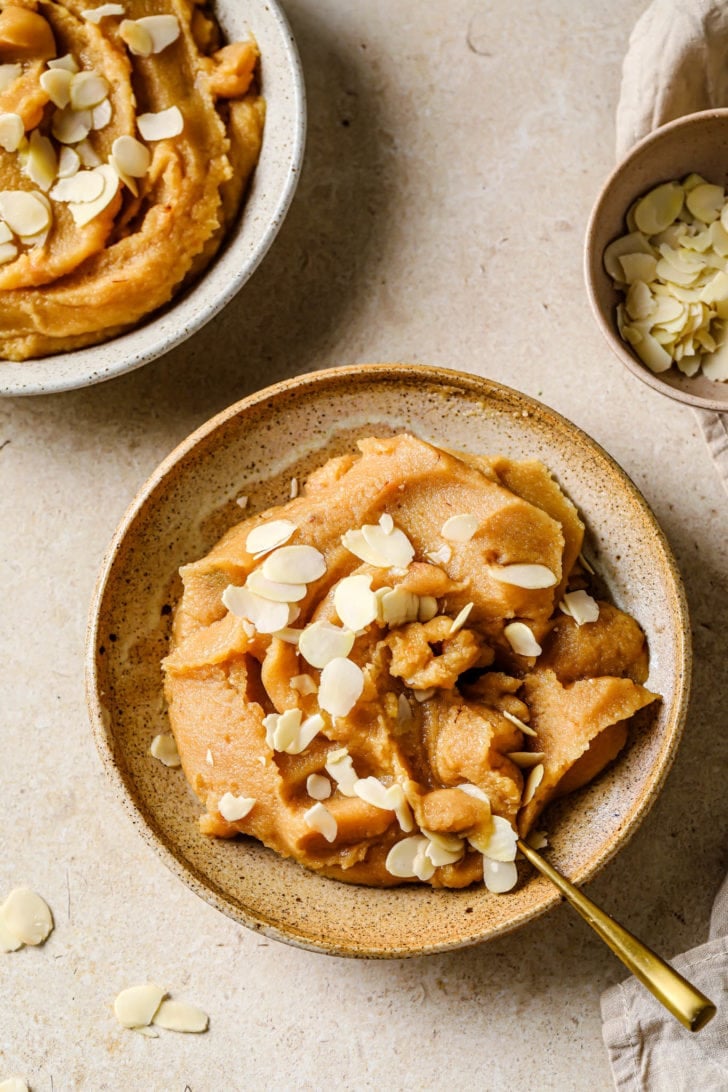
Want to save this post?
Enter your email below and get it sent straight to your inbox. Plus, get recipes & tips every week!
“I have always wanted to make a good suji ka halwa, and tried many recipes on the internet. Yours is the only one that has worked perfectly!! Thanks you so much!!”
Moizzah
Top 5 Tips to Make Sooji ka Halwa
Sooji ka halwa is considered the one of the easiest of all Indian & Pakistani desserts. But when I first started cooking, I had no idea how to transform the packet of coarse, ivory-colored flour into the miraculous, tender mass of beads that is Sooji Ka Halwa.
In fact, back then it took me a couple (okay, several) tries to perfect this recipe. I’ll go on to embarrass myself by pretty much giving away the many ways in which I messed it up:
- Embrace stirring. Seriously, you’re going to be stirring constantly.
- Thoroughly roast the semolina over low-ish heat until you no longer have to question whether it’s roasted. This will demand patience. And stirring.
- Boil the sugar and water mixture separately instead of throwing it in with the browned semolina. (Those old-school methods had some deep logic steeped into them.)
- Do not skimp on the butter or ghee. Not only are they natural fats approved by ancients, but this recipe’s amount is actually on the lower end. 😇
- For traditional texture, use fine, not coarse, semolina.
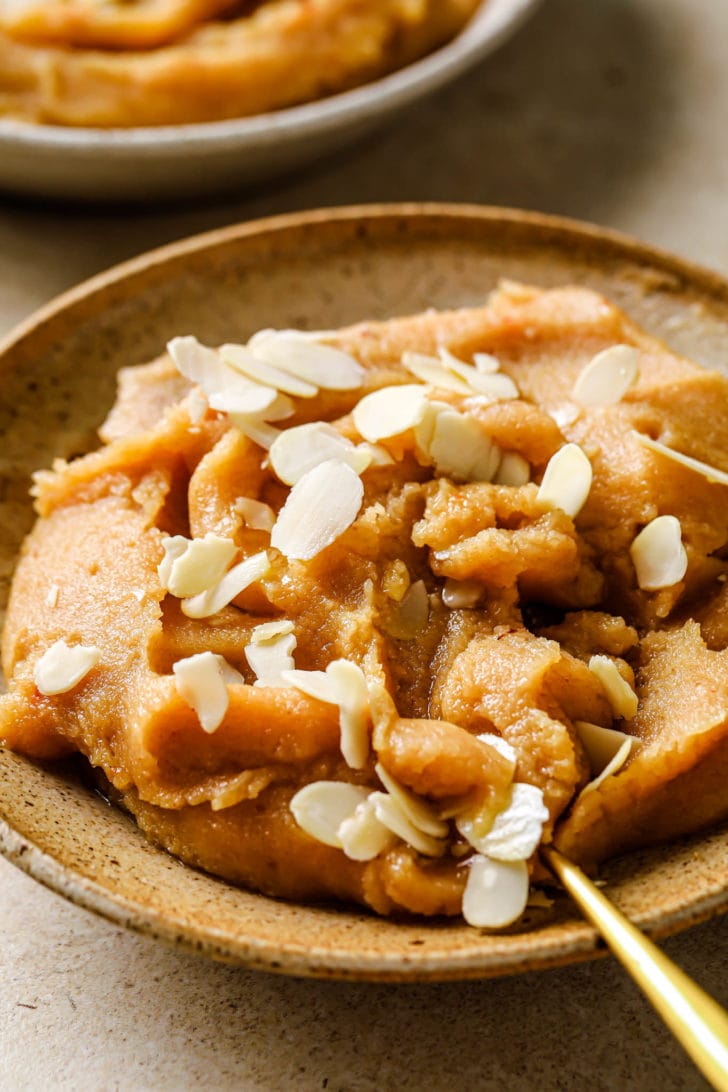
What is Sooji ka Halwa?
Halwa, which comes from the Arabic root “helw”, means “sweet”, is said to be Persian in origin.
Though most people associate halwa with the Middle Eastern confectionery, halwa in the South Asian context is essentially the transformation of an ingredient into a dessert.
Halwa can be made with everything from carrots, to nuts, or even dal. Sooji halwa is halwa made from semolina, or flour made from ground Durum Wheat.
More Quick and Easy Desserts: 20-Minute Sheer Khurma, Instant Pot Kheer, Crushed Pineapple Dessert
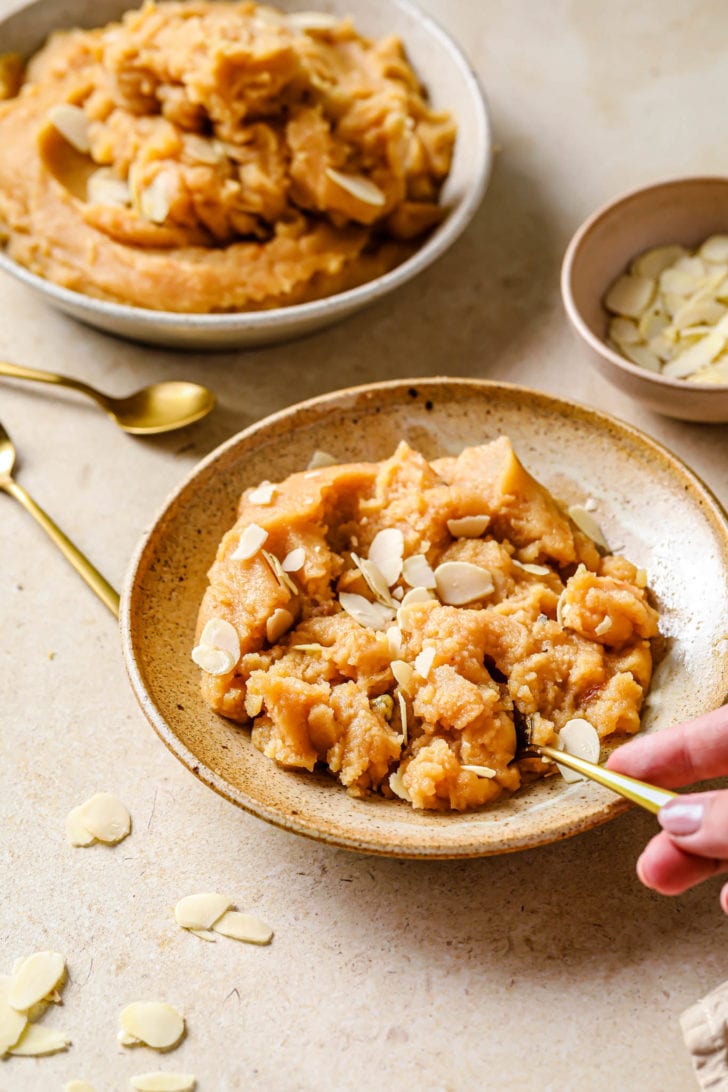
2 Types of Sooji Halwa
Though the basic method for making Sooji ka Halwa is the same, there are two prominent versions of it.
- Regular Sooji Halwa: This simple, homemade version is the one I’m sharing. It’s made with all kinds of variations and add-ons such as nuts and raisins. Unlike restaurant halwa, this one is naturally wheat colored and usually served for dessert.
- SoojiHalwa for Halwa Puri: This restaurant-style halwa is served for brunch. It’s eaten alongside a spicy Chana Masala and a tangy potato curry with pooris or parathas. In comparison to the homemade version, the restaurant version is:
- Roasted for a shorter time, so it doesn’t have the deep, wheat-color.
- More liquidy.
- Usually orange-colored due to food coloring, which is added to the sugar syrup.
- More oily, as are most restaurant versions of traditional foods.
Ingredients
The basic recipe requires 5 essential ingredients, which you can build upon according to preference:
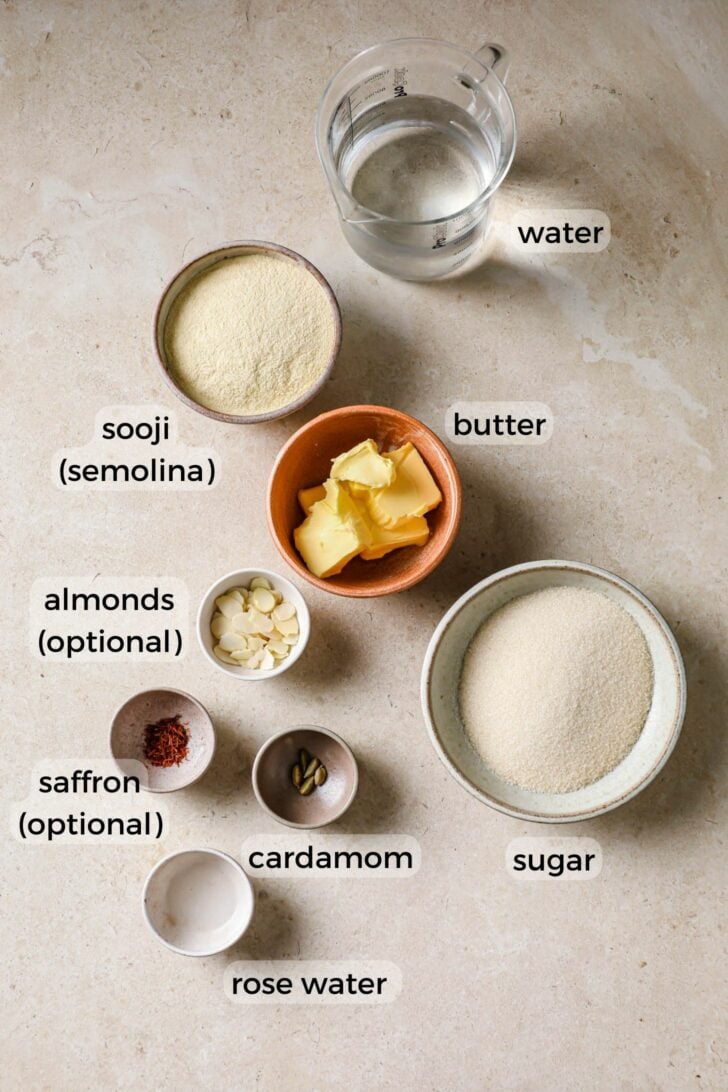
- Sooji (Semolina): Using fine semolina gives a soft, fluffy texture while coarse semolina gives more grainy results. That said, I’ve made it several times with coarse semolina and find myself enjoying the grainier texture. (Leftover sooji can be used to make Panjeeri.)
- Butter or Ghee: Ghee is the traditional choice, but good-quality butter is great in halwa. To make it vegan, use oil in place of ghee/butter.
- Water: The amount of water will determine the texture. If you want it to be more grainy to be eaten alone, you can use as little as 2 cups of water. If you want softer and thicker halwa like the one used for ‘halwa poori’, use up to 3 cups of water. 2.5 cups is a happy medium, which is what the recipe calls for.
- Cardamom pods: If you don’t want pods and seeds in your halwa, substitute with a pinch of ground cardamom powder.
- Rose water: I use Cortas brand. Depending on how strong your rose water is, you may want more or less than the recipe amount. If you don’t like rose water or don’t have it on hand, you can omit.
- Saffron (optional): Crush a few strands between your fingers before using.
- Blanched, slivered almonds (optional, for garnish): You can also add raisins, roasted pistachios, or other chopped nuts. If you’d like them toasted (like how they are in Sheer Khurma), lightly sauté them in ghee/butter for 2-3 minutes before using.
How To Make Sooji Ka Halwa
Here’s the classic method:
- Melt butter or ghee and roast the semolina. You want a nutty aroma with a visible change in color. While you’re waiting for it to change color, move on to the next step.
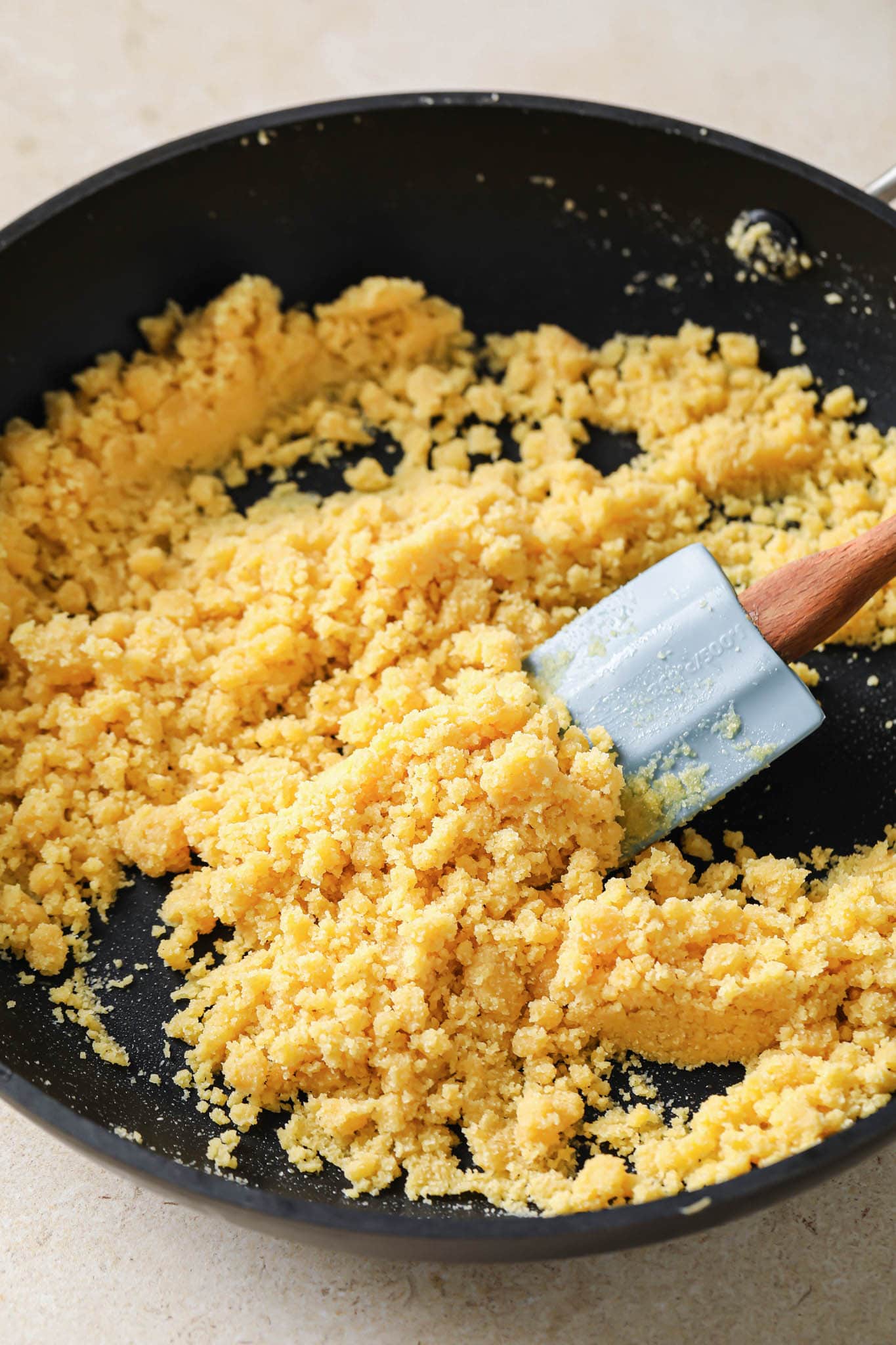
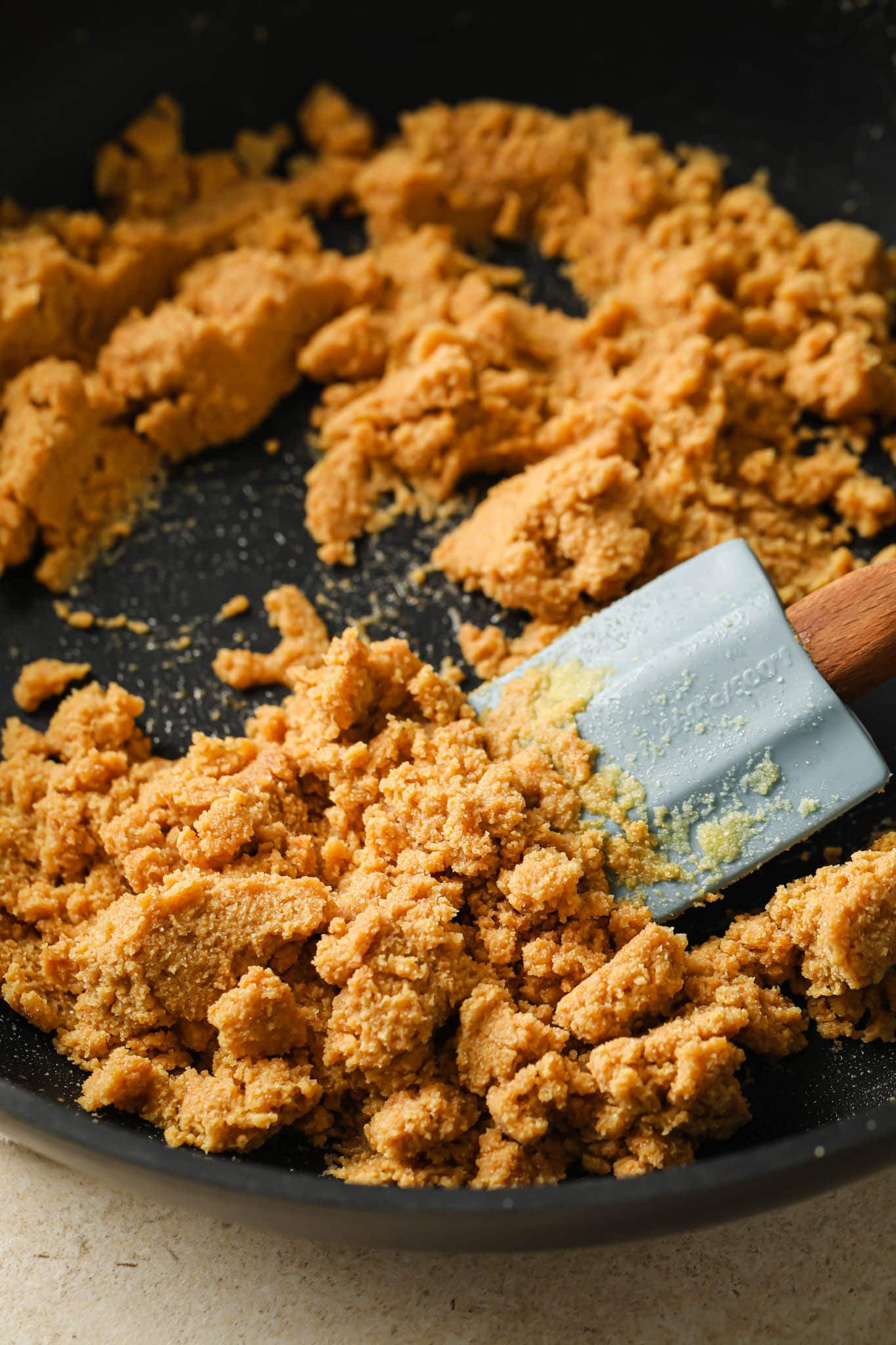
Not only does roasting enhance the flavor, it also makes the texture so the tiny beads don’t bind to each other to create one, big, sticky mass.
- Combine the sugar, water, and cardamom in a saucepan. No need to boil or thicken it. The goal is to simply dissolve the sugar. Remove from heat and add the saffron & rose water, if you’re using it.
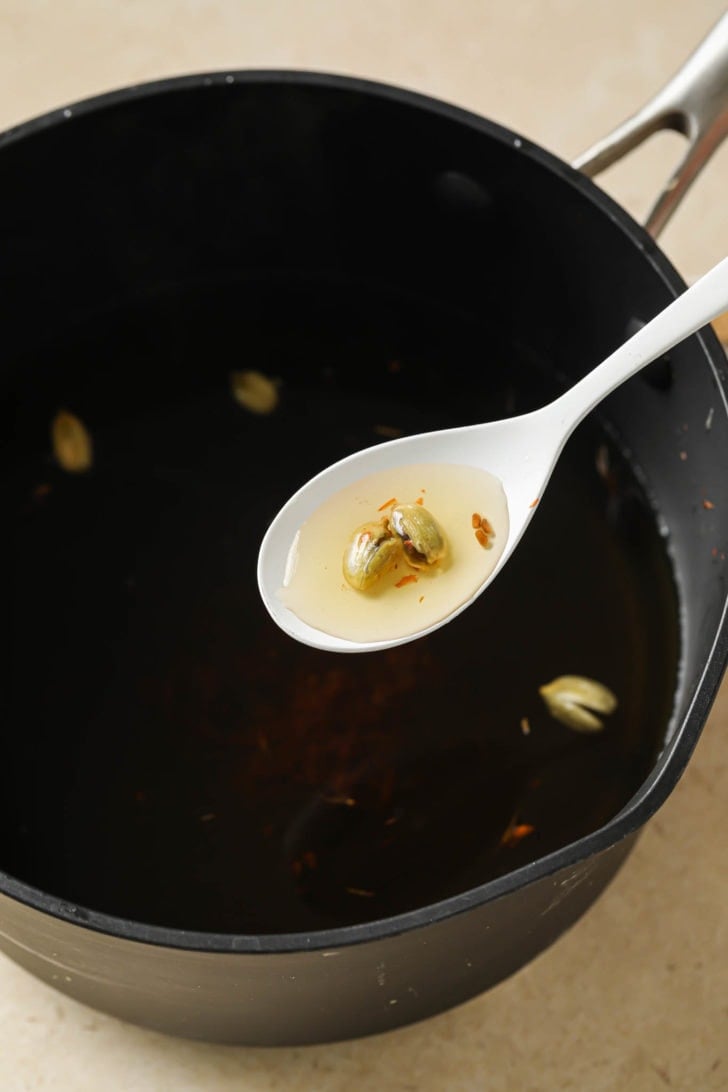
- Add this to the roasted semolina to moisten it. It’ll sizzle and splash. The semolina will absorb the water and go from crumbly to plump and fluffy.
- Continue to stir. Once you notice the butter/ghee starting to separate from the halwa on the edges, turn off the heat.
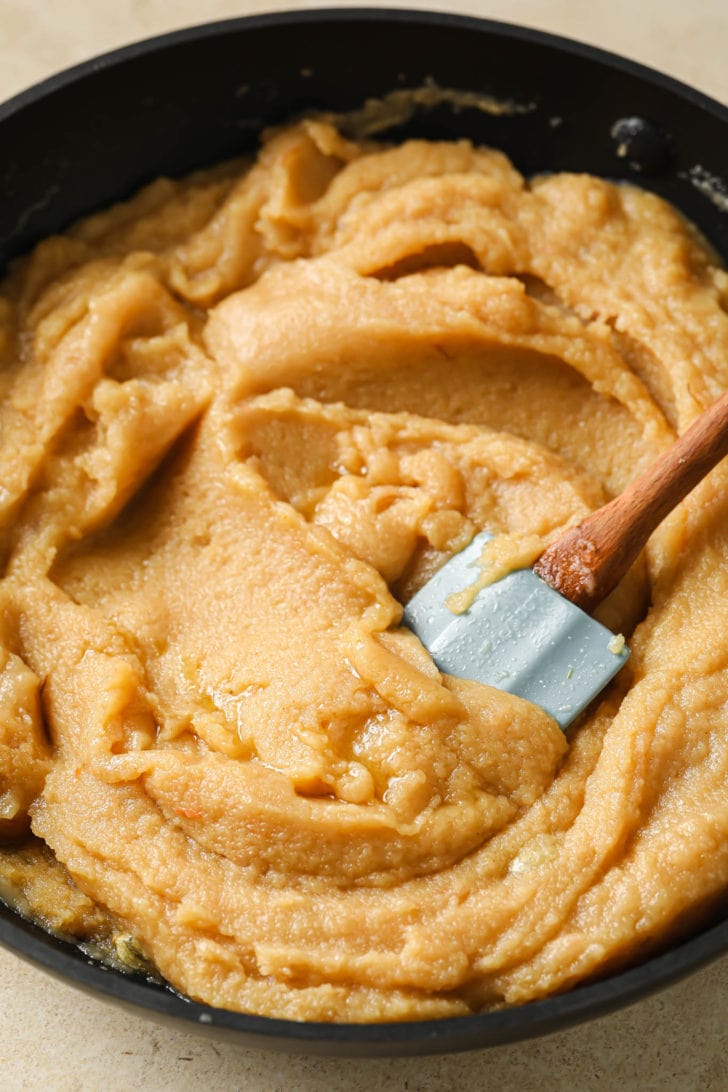
- Garnish with slivered almonds. Serve immediately or cover in an airtight container until ready to serve.
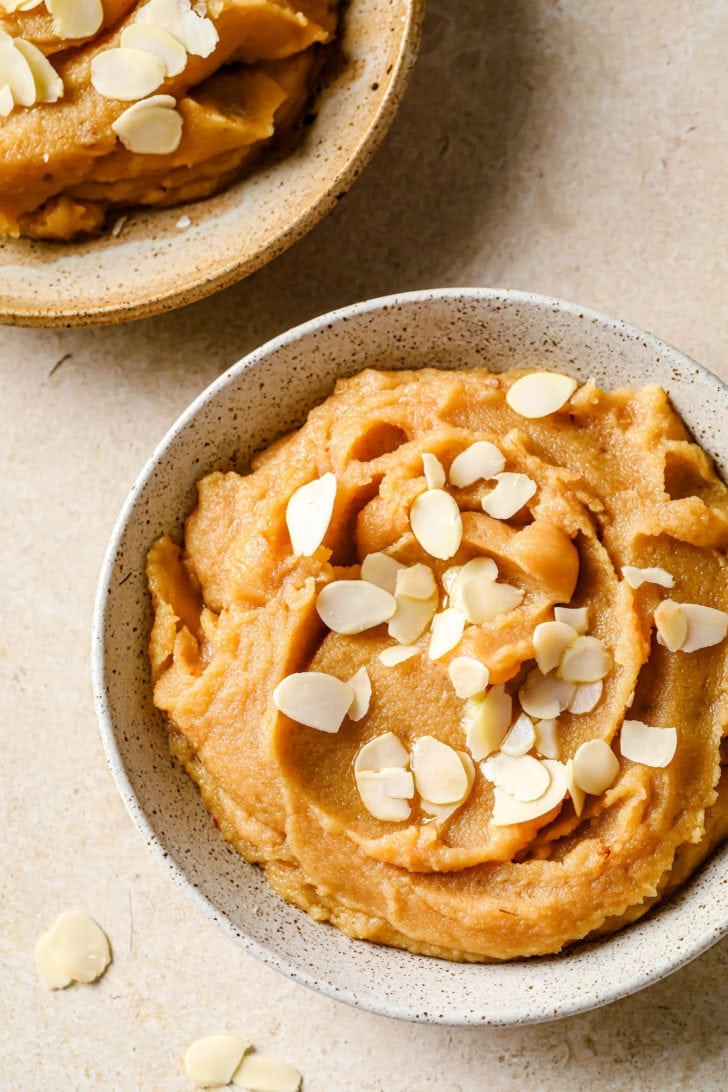
Variations
Sooji ka Halwa takes well to all kinds of fun variations:
- Salt: I’ve tried using salted butter and though it gave a beautiful flavor, the salt was a little too evident. A safer option is to use 1/4 cup salted butter, 1/4 cup unsalted, or just add a pinch of salt.
- Milk: To make it creamier, add 1/2 cup milk once the water has absorbed.
- Egg: My aunt always adds a whisked egg after the water has absorbed. Sounds weird, but I’ve tried & enjoyed it.
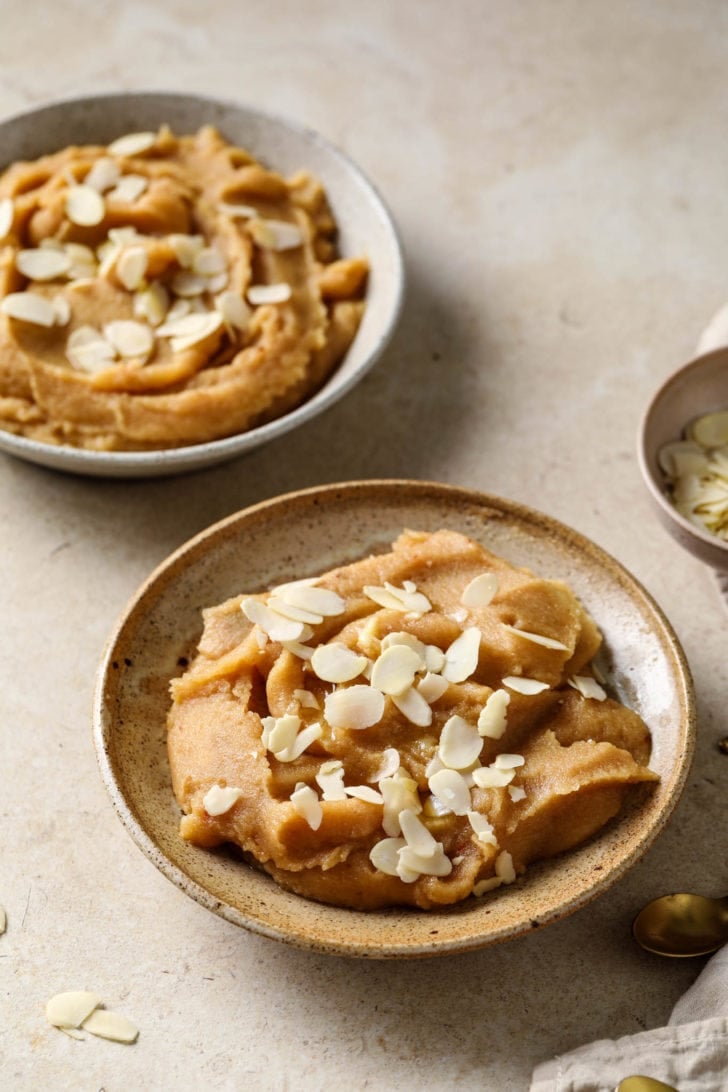
How to Serve
Sooji ka Halwa is usually served hot or warm, but it’s also fine at room temperature. Serve it for dessert, breakfast, or a snack for when you’re craving something sweet yet filling.
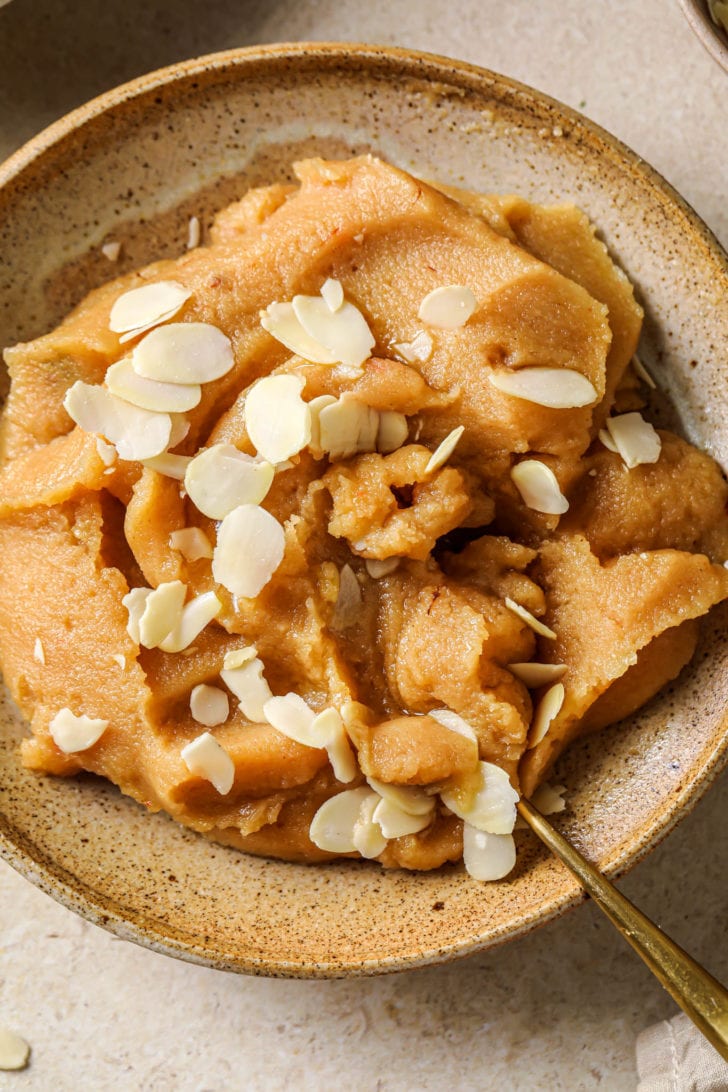
More Pakistani & Indian Desserts You’ll Love
- 20-Minute Seviyan (Sheer Khurma)
- The Best Instant Pot Kheer (Restaurant Recipe)
- Zarda (Sweet Rice)
- Instant Pot Carrot Halwa (Gajar ka Halwa)
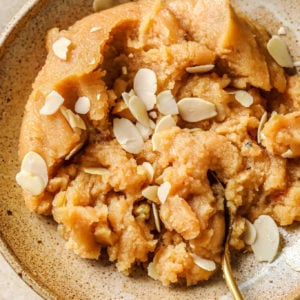
Sooji ka Halwa (Semolina Halwa) – 20 Minute Recipe!
Watch the Video
Ingredients
- 1/2 cup (112 g) unsalted butter or ghee, See Note 1
- 1 cup (156 g) fine semolina, sooji
- 2 1/2 cups water , See Note 2
- 3/4 cup (150 g) raw cane sugar or turbinado (demerara) sugar, See Note 3
- 4-5 cardamom pods, slightly cracked open
- 1/2 tsp rose water
- pinch saffron strands, lightly crushed between your fingers, optional
- 1-2 tbsp slivered almonds, for garnish (optional)
Equipment
- large (preferably non-stick) skillet for roasting semolina
- Small Saucepan for sugar syrup
Instructions
- Heat a large, nonstick skillet over medium-low heat. Add the butter or ghee and once it melts, immediately add the semolina (sooji).
- Cook the semolina, stirring frequently, until it roasts evenly and turns deep golden in color (~12-14 min). Depending on your stovetop, you may need to raise the heat to help it come to the roasting point. Then lower the heat if needed. Meanwhile, start with the sugar syrup.
- In a small to medium saucepan, bring the water, sugar, and cardamom pods to a simmer. Stir until the sugar is dissolved, then remove from heat. Add the rose water and saffron, if using.
- Add the sugar syrup carefully into the browned semolina. Continue to stir for 3-4 minutes, until the mixture thickens and the butter starts to separate from the semolina. Sometimes I like to add a tablespoon of ghee at this point to give it a nice finish.
- Garnish with slivered almonds. Serve hot, warm, or at room temperature. If you're not serving immediately, store in an airtight container to prevent it from drying out.
Notes
- Sweeteners: You can also use plain, granulated sugar or even light brown sugar.
- If you want it sweeter, you can always add 1-2 tbsp after adding the sugar syrup to the sooji.
- Salt: I’ve tried using salted butter and though it gave a beautiful flavor, the salt was a little too evident. A safer option is to use 1/4 cup salted butter, 1/4 cup unsalted, or just add a pinch of salt.
- Milk: To make it creamier, add 1/2 cup milk once the water has absorbed.
- Egg: My aunt always adds a whisked egg after the water has absorbed. Sounds weird, but I’ve tried & enjoyed it.
- Keeps well in in the fridge when stored in an airtight container for 3-4 days. Reheat in the microwave.
- Keeps well in the freezer for 1 month. Defrost before reheating. If you want to get it liquidy again, add a splash of boiling water.
This post was originally published in November of 2016. It’s since been updated with new pictures, video (coming soon!), and a slightly refined version of the original recipe.


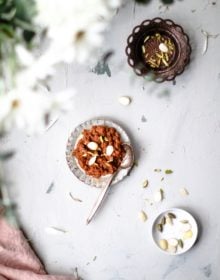
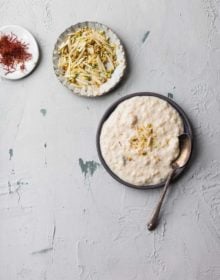
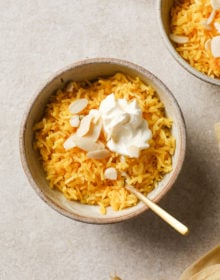
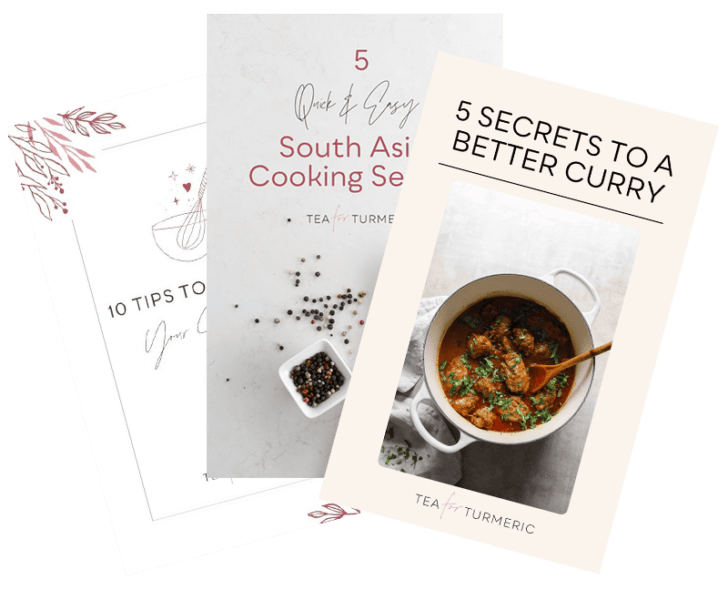
31 Comments on “Sooji ka Halwa (Semolina Halwa) – 20 minute Recipe!”
Easy recipe to follow and delicious. I’ve made this with once with margarine and another time sunflower oil to make it vegan and it turned out great both times, thank you!
So glad to hear you enjoyed the Halwa. Thank you for sharing that it worked with margarine and sunflower oil!
I used this recipe for my first time at making halwa – it was great! It was simple and requiring just kitchen stapes (bar the semolina).
I added some green raisins and crushed almonds in the end – yummy!
So happy you enjoyed and love the additions. Thanks for taking the time to share!
This was easier than expected and I made it thicker using 2 cups of water as suggested and cooking it a bit longer and I was able to cut it into diamond shapes! Its yum!
That sounds like such a great idea! Thank you for sharing 🙂
Outstanding everything I make sooji!
So glad you enjoyed it Shara!
Not sure why I’ve always found halwa intimidating to make lol but this was very straight forward and delicious! Followed recipe to a T minus the saffron and it came out amazing! Thank you
Yay! We’re so happy to hear you enjoyed and found it easy to make!